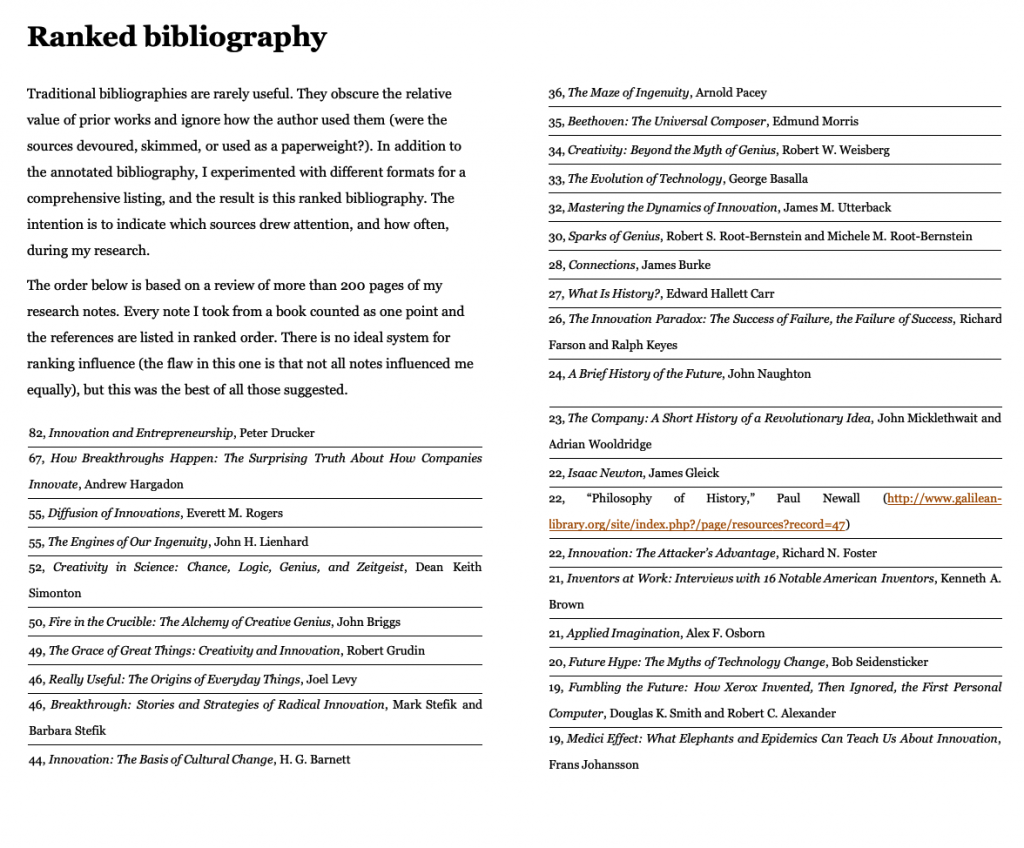Innovation in a book about Innovation?
When I wrote the original edition of Myths of Innovation, I asked you folks for ideas to make a book itself innovative. There were some good ideas, some of which made it into the book. A full list of the books referenced can be found here.
One idea I had was the ranked bibliography, shown below, where instead of listing my sources alphabetically, which is useless, I listed them in order of how influential they were in notes. Not many people noticed, but some did.
Here’s what it looked like (click to get a better view):
It’s been a few years since that first post. Two new questions:
- Have you seen books recently that did something clever you wish other books did?
- Are there other little details like the bibliography that you wish books included?
I’m working on the paperback edition now. So the time is good if you have clever ideas I might be able to work in.


Hi Scott — I’m looking forward to hearing you speak at WordCamp SF on May 1. In the meantime, I think there’s a missing word in today’s post — should “When I wrote the original edition of Myths of Innovation, I asked you folks for to make a book itself innovative.” be “When I wrote the original edition of Myths of Innovation, I asked you folks for IDEAS to make a book itself innovative.”?
Regards,
Caleigh Lynn Hall
Scott
The table of contents in Pull by David Siegel are amazing:
https://www.amazon.com/exec/obidos/ASIN/1591842778/scottberkunco-20/
The entire design of the book is unlike anything that I have ever seen.
Unfortunately, you can’t search within the book on Amazon.
Phil
Caleigh: Fixed! thx
I have to admit I was a big fan of your heavily annotated bibliography in making things happen, it was almost as valuable as the rest of the book, and cost me a few hundred dollars on bookdepository :)
I’d really like to see more ranked bibliographies!
An elastic strap like the Moleskine sketchbooks have would make any book more ‘portable’: Doesn’t matter if your bag is quite full, you realize your train stop is here already and you have bookmarks and notes everywhere… just close the book with the strap, throw/stuff it in the bag and run.
Create a digital version either as an app or an iBook. I’ve been blown away by the new reading experiences I have had on my iPad. If given the option between an iBook and a paper book, I will almost always choose the iBook. Bookmarking, ability to search, dictionary lookups (I’d like to see some industry specific dictionaries integrated into iBooks)…. All awesome.
I really like your ranked bibliography. As an app or iBook, it would be awesome to be able to select the item in the bibliography and then automatically bookmark every reference.
Hi,
In the table of contents, mention the ‘expected reading time’ in minutes.
I read the Myths mostly on trains and busses. I wanted to finish a chapter (or another logical unit) each time, so I compared lengths and chose that part with the best ‘expected reading time’ – ‘available reading time’ match.
Best regards,
Sara Vermeylen
I’ve always liked the idea of a 400 page book starting chapter 1 at page 400 and counting down so that last page is 1. Readers would hopefully be able to handle saying they’re on page 100 and other readers knowing exactly wht they mean.
Gives more of an idea as to how you are progressing in the book and as confessions of public speaker suggests we all like an exciting countdown.
I’d like to take credit for this thinking but in the back of my mind I think I may have read it in an Edward de Bono book.
Any future plans to visit the UK by the way?
Cheers, The Idea Hunter
A friend once showed me an advanced math textbook where the authors, after completing their script, handed it off to several witty students. The students took their turns writing comments in the margins and responding to comments from previous reviewers. At the end, the comments were typed up and published in the margins.
In this case, the content matched well with the comments. Something normally very jargon heavy suddenly had a human side brought to bear on it.
Comments included things like: “What do you even call that variable?” [in reference to some obscure greek character] to “Start skimming…”, later, “Start skipping…”, then “Stop Skipping”, “Stop Skimming”.
In the end, the comments added depth to the work that wasn’t possible with traditional text. I don’t know if this would be helpful in a non-fiction book, but it certainly seems like a derivative of this idea could add additional depth to the text.
Well maybe it’s about the post-it notes. Someday I need to stick the post-it notes where I didn’t see any blank area to post it. While most people chose to post it anywhere they like or put small writings near the corner or small path near the edge of the paper, I think it’s quite hard to re-read again.